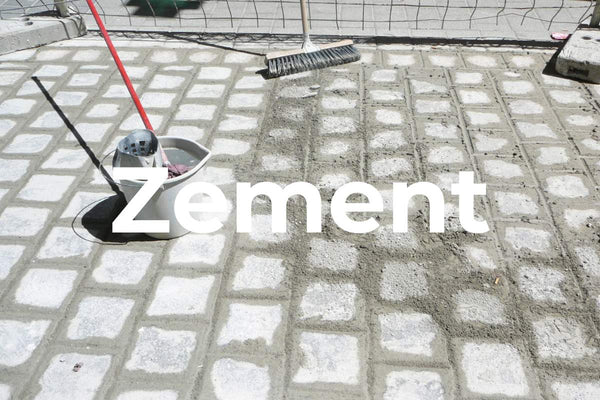
Tile Grout - The Ultimate Guide to Selection and Application
Share
Guide to choosing the right grout: from selection to application
Are you looking for the perfect grout for your tiles?
Don't worry we got you through this jungle!
In this article, we'll go through everything you need to know about grout, from the different types to tips and tricks for application.
1. What is grout?

Grout is an important element in the world of tiles.
It is used to fill the spaces between the tiles and has many advantages:
- including aesthetics
- waterproofness
- additional protection of the tiles.
Our tip: Calculate your tile grout requirements with our practical calculator .
2. Different types of grouts

There are different types of grout, each with their own benefits and uses in tiling .
Let's take a close look at some of them:
2.1 Cement based grout
Cement based grout is the most common type of grout. It's easy to use, durable and comes in a variety of colors.

Advantages of cement-based grout:
- Easy to Use: Cement based grout is easy to mix and apply.
- Durability : It provides a strong and durable seal that can stand the test of time.
- Variety of colors: It is available in a wide range of colors to give your project the look you want.
- Inexpensive: It is usually cheaper than other joint compounds.
2.2 Epoxy grout

Epoxy grout is another option. It is particularly resistant to moisture and chemicals, making it ideal for bathrooms and kitchens.
Advantages of epoxy resin tile grout:
- Moisture and Chemical Resistant: Epoxy grout is highly resistant to moisture and chemicals, making it ideal for bathrooms and kitchens.
- Hardness: It provides a very hard and durable surface that resists cracking and chipping.
- Easy to clean: Due to its smooth and non-porous surface, it is easy to clean.
2.3 Silicone joint compound
Silicone grout is ideal for areas that are constantly exposed to water or moisture.

It is elastic and can expand and contract with the movement of the tiles without tearing.
Advantages of silicone joint compound:
- Elasticity: Silicone grout is flexible and can expand and contract with the movement of the tiles without cracking.
- Waterproof: It offers excellent waterproofing, making it ideal for areas exposed to constant water or moisture.
- Temperature resistance: It withstands temperature fluctuations and is therefore well suited for rooms with large temperature differences.
- Easy to work with: It is relatively easy to work with and apply.
Our tip: Use a silicone squeegee for clean tile silicone edges.
2.4 Joint sealants for special applications
There are also special grouts for specific applications, such as heat-resistant chimney grout and frost-resistant outdoor grout.
Guide for tile grout from practice
- Lay ceramic tiles
- Grout expansion joints for tiles
- Tools for laying tiles
- Sand tile joints
3. Choosing the right grout
Choosing the right grout depends on many factors including the location, the type of tile and the desired aesthetic. It's important to consider all options to make the best choice for your project.
4. Proper application of joint compound

Applying grout can be a little tricky, but with the right technique and practice, you'll be mastering it in no time.
Here's a step-by-step guide to get you started.
4.1 Step-by-step instructions
- Prepare the tile surface
- Mix the grout
- Apply the grout
- Let the grout dry
- Clean the area
5. Joint compound in practice: tips and tricks
5.1 How to properly mix joint compound
The correct consistency of the grout is crucial for a successful application. It hardly differs from the usual concrete mixture .
Our tip: It should have the consistency of peanut butter - not too runny, but not too thick either.
5.2 How to properly apply grout
When applying grout it is important to work in small areas and draw the grout diagonally across the tiles to completely fill the grout.
5.3 How to properly clean grout
Once the grout has dried, use a damp sponge to remove excess grout. Be careful not to damage the freshly filled joints.
6. Summary and conclusion - The choice of the right grout must be made individually
Choosing and applying the right grout can make all the difference when it comes to taking your tile projects to the next level.
With the right information and techniques, you can achieve a professional result that is both aesthetically pleasing and durable.
Our recommendation: Atile trowel can make working with the grout much easier.
7. Frequently asked questions about tile grout

1. What type of grout is best for bathrooms?
Epoxy and silicone grouts are particularly good for bathrooms because of their water resistance.
2. How long does it take for the grout to dry?
Drying time will vary depending on the type of grout, but it is best to wait at least 24 hours before using the surface again.
3. Can I paint over old grout?
It's usually best to remove old grout and apply new for best results. The best, cheapest and most efficient tool for such tile work is a diamond burr.
4. How often should I redo my tile grout?
The grouts should be renewed every one to two years, depending on their exposure to moisture and wear
